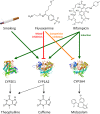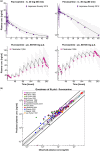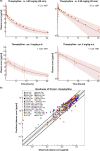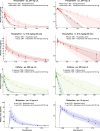Physiologically-Based Pharmacokinetic Models for CYP1A2 Drug-Drug Interaction Prediction: A Modeling Network of Fluvoxamine, Theophylline, Caffeine, Rifampicin, and Midazolam
- PMID: 30762305
- PMCID: PMC6539736
- DOI: 10.1002/psp4.12397
Physiologically-Based Pharmacokinetic Models for CYP1A2 Drug-Drug Interaction Prediction: A Modeling Network of Fluvoxamine, Theophylline, Caffeine, Rifampicin, and Midazolam
Abstract
This study provides whole-body physiologically-based pharmacokinetic models of the strong index cytochrome P450 (CYP)1A2 inhibitor and moderate CYP3A4 inhibitor fluvoxamine and of the sensitive CYP1A2 substrate theophylline. Both models were built and thoroughly evaluated for their application in drug-drug interaction (DDI) prediction in a network of perpetrator and victim drugs, combining them with previously developed models of caffeine (sensitive index CYP1A2 substrate), rifampicin (moderate CYP1A2 inducer), and midazolam (sensitive index CYP3A4 substrate). Simulation of all reported clinical DDI studies for combinations of these five drugs shows that the presented models reliably predict the observed drug concentrations, resulting in seven of eight of the predicted DDI area under the plasma curve (AUC) ratios (AUC during DDI/AUC control) and seven of seven of the predicted DDI peak plasma concentration (Cmax ) ratios (Cmax during DDI/Cmax control) within twofold of the observed values. Therefore, the models are considered qualified for DDI prediction. All models are comprehensively documented and publicly available, as tools to support the drug development and clinical research community.
© 2019 The Authors CPT: Pharmacometrics & Systems Pharmacology published by Wiley Periodicals, Inc. on behalf of the American Society for Clinical Pharmacology and Therapeutics.
Conflict of interest statement
T.E., T.W., and S.F. are employees of Bayer AG. A.K.V. performed this work at the Saarland University. Since January 2018, she is an employee of the Federal Institute for Drugs and Medical Devices (BfArM) and declares no potential conflicts of interest with respect to the research, authorship, and/or publication of this article. No potential conflicts of interest were disclosed by the other authors.
Figures





Similar articles
-
Interaction profile of armodafinil with medications metabolized by cytochrome P450 enzymes 1A2, 3A4 and 2C19 in healthy subjects.Clin Pharmacokinet. 2008;47(1):61-74. doi: 10.2165/00003088-200847010-00006. Clin Pharmacokinet. 2008. PMID: 18076219
-
Effect of capmatinib on the pharmacokinetics of substrates of CYP3A (midazolam) and CYP1A2 (caffeine) in patients with MET-dysregulated solid tumours.Br J Clin Pharmacol. 2023 Mar;89(3):1046-1055. doi: 10.1111/bcp.15544. Epub 2022 Oct 17. Br J Clin Pharmacol. 2023. PMID: 36131603
-
Physiologically Based Pharmacokinetic Models for Prediction of Complex CYP2C8 and OATP1B1 (SLCO1B1) Drug-Drug-Gene Interactions: A Modeling Network of Gemfibrozil, Repaglinide, Pioglitazone, Rifampicin, Clarithromycin and Itraconazole.Clin Pharmacokinet. 2019 Dec;58(12):1595-1607. doi: 10.1007/s40262-019-00777-x. Clin Pharmacokinet. 2019. PMID: 31129789 Free PMC article.
-
Physiologically based pharmacokinetic model to predict drug-drug interactions with the antibody-drug conjugate enfortumab vedotin.J Pharmacokinet Pharmacodyn. 2024 Oct;51(5):417-428. doi: 10.1007/s10928-023-09877-5. Epub 2023 Aug 26. J Pharmacokinet Pharmacodyn. 2024. PMID: 37632598 Free PMC article. Review.
-
Clinically significant pharmacokinetic interactions between dietary caffeine and medications.Clin Pharmacokinet. 2000 Aug;39(2):127-53. doi: 10.2165/00003088-200039020-00004. Clin Pharmacokinet. 2000. PMID: 10976659 Review.
Cited by
-
A physiologically-based pharmacokinetic precision dosing approach to manage dasatinib drug-drug interactions.CPT Pharmacometrics Syst Pharmacol. 2024 Jul;13(7):1144-1159. doi: 10.1002/psp4.13146. Epub 2024 May 1. CPT Pharmacometrics Syst Pharmacol. 2024. PMID: 38693610 Free PMC article.
-
Data Digitizing: Accurate and Precise Data Extraction for Quantitative Systems Pharmacology and Physiologically-Based Pharmacokinetic Modeling.CPT Pharmacometrics Syst Pharmacol. 2020 Jun;9(6):322-331. doi: 10.1002/psp4.12511. Epub 2020 Jun 16. CPT Pharmacometrics Syst Pharmacol. 2020. PMID: 32543786 Free PMC article. Review.
-
COVID-19 and antiepileptic drugs: an approach to guide practices when nirmatrelvir/ritonavir is co-prescribed.Eur J Clin Pharmacol. 2022 Oct;78(10):1697-1701. doi: 10.1007/s00228-022-03370-7. Epub 2022 Aug 5. Eur J Clin Pharmacol. 2022. PMID: 35930055 Free PMC article. Review.
-
A Physiologically-Based Pharmacokinetic (PBPK) Model Network for the Prediction of CYP1A2 and CYP2C19 Drug-Drug-Gene Interactions with Fluvoxamine, Omeprazole, S-mephenytoin, Moclobemide, Tizanidine, Mexiletine, Ethinylestradiol, and Caffeine.Pharmaceutics. 2020 Dec 8;12(12):1191. doi: 10.3390/pharmaceutics12121191. Pharmaceutics. 2020. PMID: 33302490 Free PMC article.
-
Optimization of initial dosage of quetiapine in schizophrenic patients: effects of fluvoxamine or duloxetine coadministration.Front Pharmacol. 2024 Nov 20;15:1496043. doi: 10.3389/fphar.2024.1496043. eCollection 2024. Front Pharmacol. 2024. PMID: 39635430 Free PMC article.
References
-
- Shimada, T. , Yamazaki, H. , Mimura, M. , Inui, Y. & Guengerich, F.P. Interindividual variations in human liver cytochrome P‐450 enzymes involved in the oxidation of drugs, carcinogens and toxic chemicals: studies with liver microsomes of 30 Japanese and 30 caucasians. J. Pharmacol. Exp. Ther. 270, 414–423 (1994). - PubMed
-
- Kalow, W. & Tang, B. The use of caffeine for enzyme assays: a critical appraisal. Clin. Pharmacol. Ther. 53, 503–514 (1993). - PubMed
-
- Karjalainen, M.J. , Neuvonen, P.J. & Backman, J.T. Rofecoxib is a potent, metabolism‐dependent inhibitor of CYP1A2: implications for in vitro prediction of drug interactions. Drug Metab. Dispos. 34, 2091–2096 (2006). - PubMed
Publication types
MeSH terms
Substances
LinkOut - more resources
Full Text Sources
Medical

